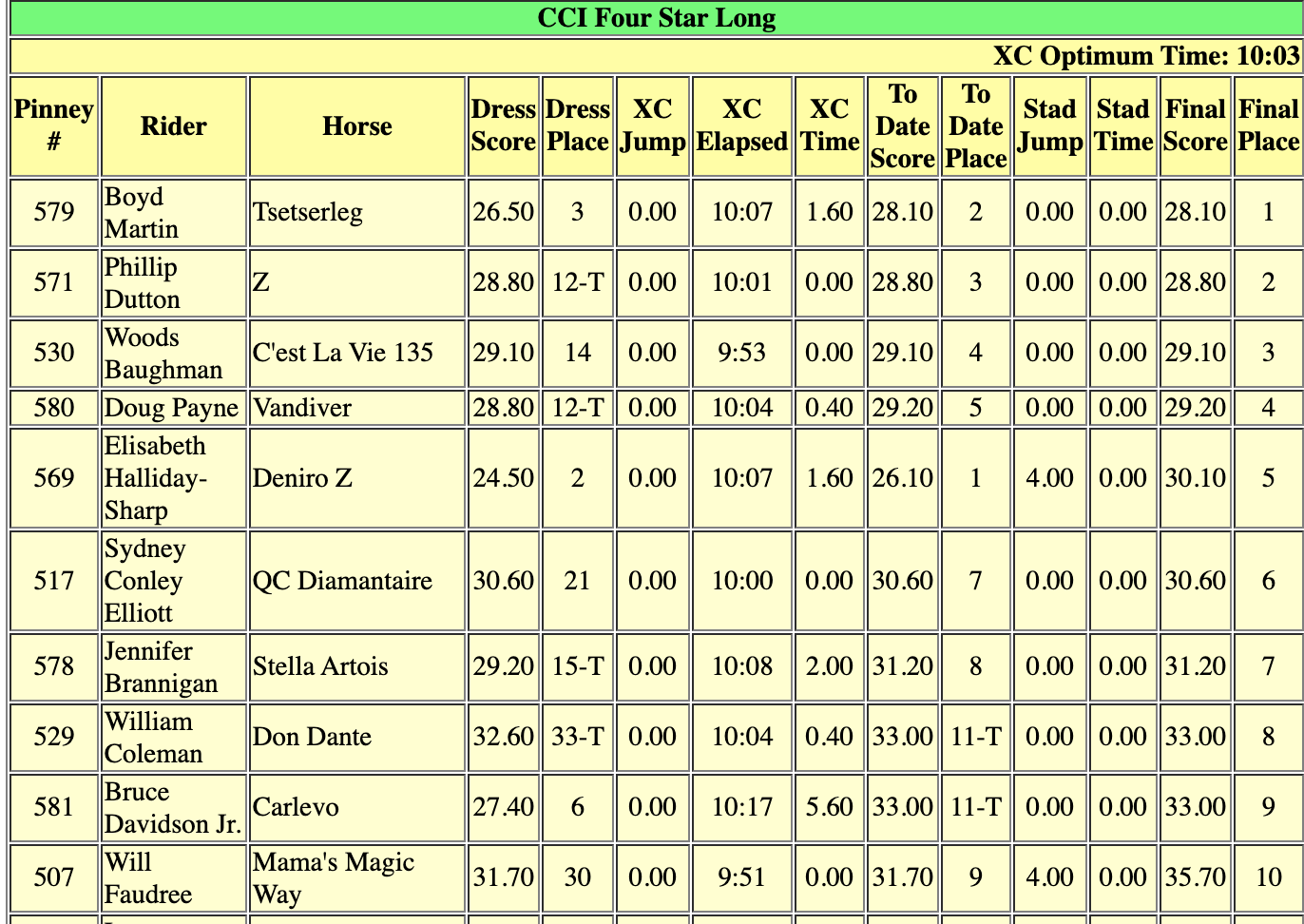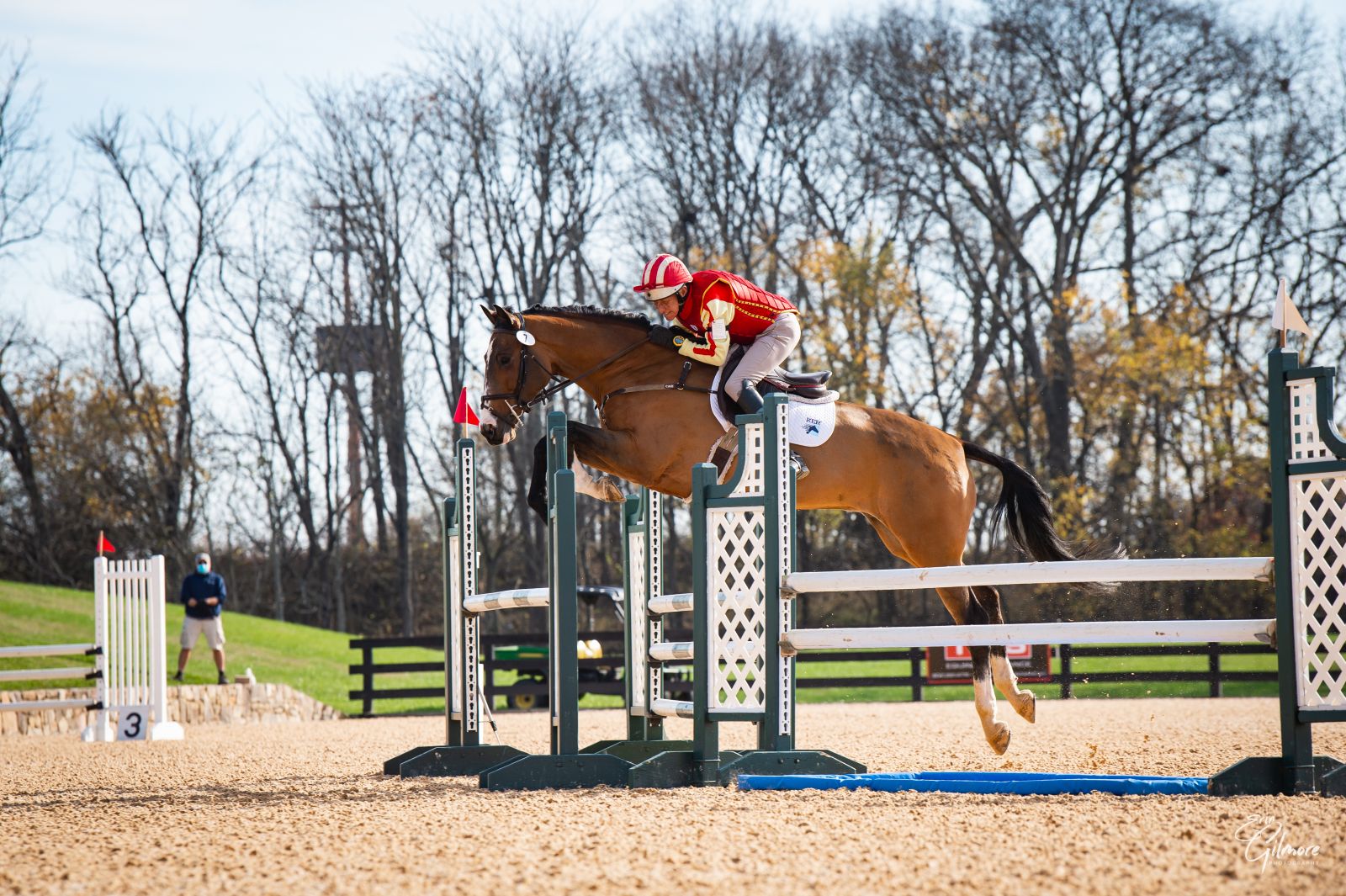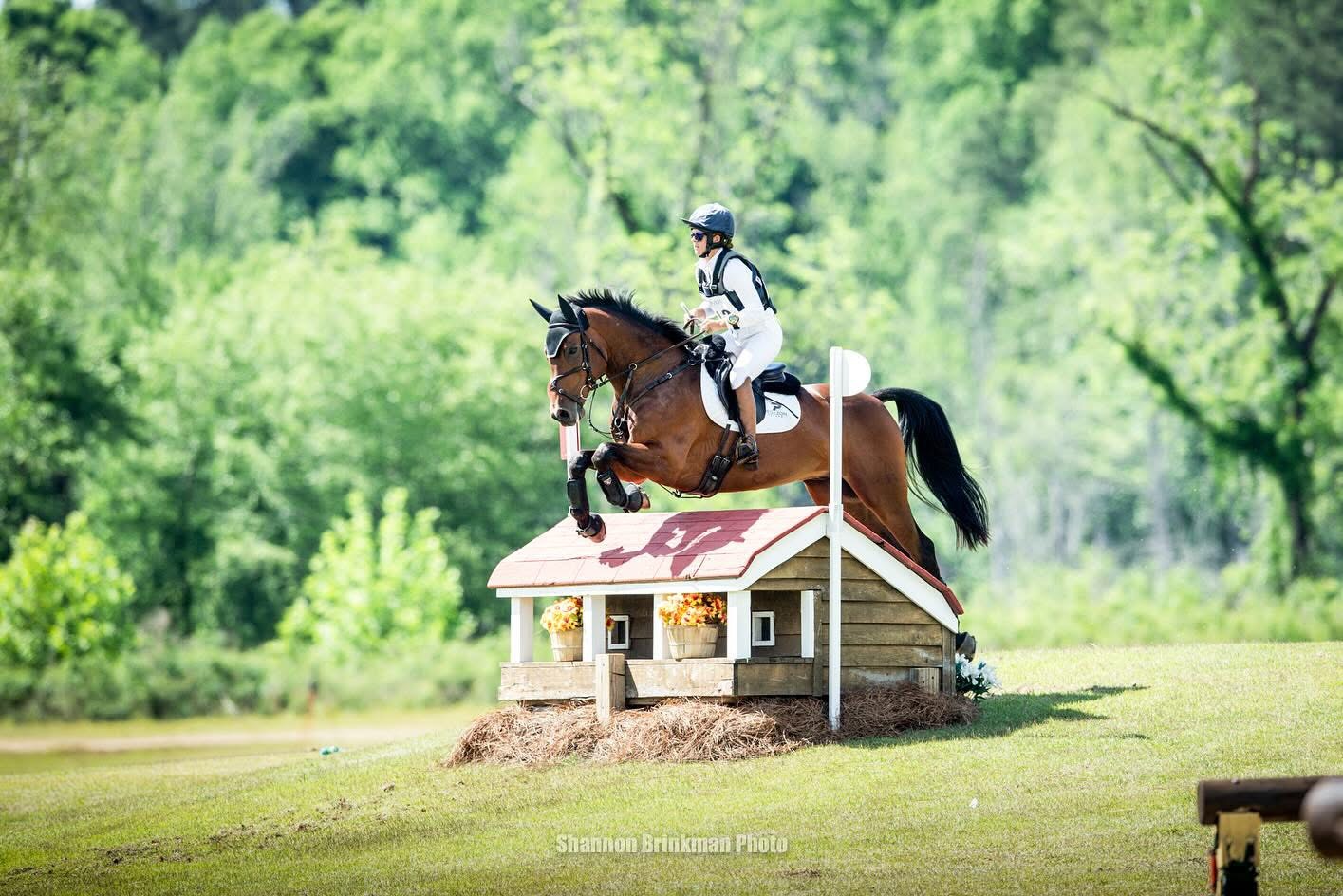
Photo courtesy of Peter Gray.
This weekend is a big finale for a short season as we look ahead to crowning a new Buckeye Nutrition CCI4* USEF National champion. On their way to winning the title, horses and riders will have to tackle today’s Captain Mark Phillips-designed cross country course. Our resident statistician, Maggie Deatrick, has taken the time to provide an excellent analysis of the last two days of dressage, as well as what to expect on cross country day today make sure you give it a read here.
The optimum time has been updated to 10:03 for the 5700 m long course which boasts 28 numbered obstacles and 43 jumping efforts. Horses will be running at 4 minute intervals and you can find the course map right here.
Coverage of Tryon International this weekend is brought to you by Strides for Equality Equestrians (SEE). Diversity and inclusion in all equestrian sports are important, and we’ll be bringing you tidbits on what this new organization hopes to accomplish.
MARS Tryon International: Website, Entry Status, Schedule, Order of Go, Ride Times, Live Scores, Live Stream, Coverage
2:52 PM: Scores aren’t official yet, but here are your top ten as it stands at the moment. A full repot will be along in a bit. Thanks for tuning in!

2:45 PM: And we’re done! Buck and Carlevo crossed the finish line, likely gathering some time penalties. Doug and Vandiver were just a single second over time and 0.4 time penalties. They sit third into show jumping unless Carlevo was actually under time.
2:43 PM: Doug and Vandiver have finished by now, and we’re waiting their score. Buck and Carlevo are almost home.
2:40 PM: Boyd and Thomas hav crossed the finish line in 10:06, the exact same time as Liz. That means they add 1.6 time penalties to their dressage score and slot into second over night. Buck and Doug are now the only remaining riders on course and both could sit in the top 5 at the end of the day.
2:36 PM: Our last pair out is now on course! It’s Buck Davidson and Carlevo. Doug is over The Bee at fence 18.
2:34 PM: Jennie and Stella Artois are through the finish flags and just a couple second over time, while Boyd flies through the water and over the boats at fence 21AB the Marina.
2:31 PM: Jennie is nearing the end of the course and is over fence 22 while Boyd clears 14. Our second to last starter is also now on course in Doug Payne and Vandiver.
2:29 PM: Boyd Martin and Tsetserleg are now on course and clear through the first water. They have the opportunity to slot into second overnight if they go fast and clear.
2:26 PM: We’re getting close to wrapping this thing up now. Jennie Brannigan and Stella Artois are now on course and clear through fence 12.
2:24 PM: Phillip and Z’s score has posted and came in double clear. That puts them on a 28.8 heading into show jumping and within a rail of Liz.
2:23 PM: Oh dear! Sydnet Soloman gets thrown onto Early Review’s neck after landing from fence 6B and slides off the right side. Looks like might have taken a bitof a hard fall, so we hope she’s alright.
2:19 PM: Whoops… FE Capricino runs out at the second squirrel. She opts to retire. Holly is clear trough fence 16 so far and Sydney Soloman and Early Review have just started.
2:18 PM: Holly Jacks Smither with Candy King and Victora Garland and FE Capricino are both on course and good so far.
2:15 PM: Liz and Deniro will be leaders heading into show jumping! She didn’t quite make time and brings home 1.6 time penalties, but it’s enough to guarantee the top spot overnight. Well done Liz!
2:12 PM: Liz and Deniro Z have a really fabulous round and cross the finish time we think within time! We’ll let you know as soon as we hear it’s official. Phillip and Z are through the Marina and Caroline Martin and Danger Mouse are on course now.
2:10 PM: We didn’t end up seeing much of Valerie and Favian, but they are home safe.
2:07 PM: Phillip Dutton and Z are on course now too. Liz and Deniro are clear through fence 17.
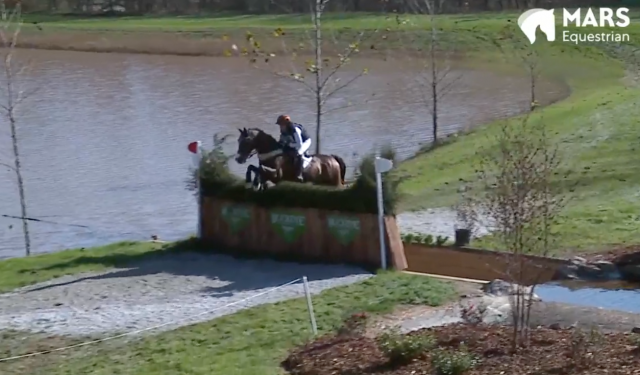
2:04 PM: Our current leaders Liz Halliday Sharp and Deniro Z are now on course and clear thus far! Since our leaders after dressage ran into trouble, the door is now open for Liz to head into show jumping as the clubhouse leader.
2:00 PM: Valerie Vizcarrondo Pride and favian are now on course and let’s catch up with some scores here as well: Andrea Baxter and Indy 500 clocked in a double clear round, Leslie Law and Voltaire de Tre came home with 5.2 in time penalties, Jules Ennis and Cooley O gathered 40.40 time penalties, and unfortunately Tamie and Danito will drop down the leaderboard with 11 penalties for knocking that frangible and they pick up 17.6 time penalties as well.
1:54 PM: We’re receiving word from the grounds grew and TD that they’re checking the landing from that drop after every horse now since so many have been pecking there. In all the excitement, we haven’t mentioned yet that both Ashlynn Meuchel with Emporium and Nilson Da Silva on Magnum’s Martini are both on course.
1:52 PM: Oh geez!! Tamie and Danito almost go down at the drop into the MARS Sustainability Bay, but she says on and saves it. They knock a flag at the corner of the big oxer out too, though not sure that will be penalized.
1:50 PM: Danito gets a bit close to the A element of 15ABC and ends up taking the frangible pin at that element. Unfortunately for Tamie, that means they won’t take over the lead. They’re on their feet though and still jumping!
1:48 PM: Dang, we have another soaked rider at the MARS Sustainability Bay as Fylicia bounces off of Galloway Sunrise on landing.
1:45 PM: Alright, both Fylicia Barr with Galloway Sunrise are Tamie Smith with Danito are on course. We missed Fylicia starting while we were admiring the jumps we hadn’t seen yet!
1:42 PM: Ooooh — we now have a camera out in the back field where fences 14, 15ABC, and 16 are. Andrea and Indy tackle the coffin at 15 flawlessly.

1:40 PM: OK phew, Tamie and Danito are just taking care of a tack issue so we’ll see them out in a bit. Meanwhile, Andrea and Indy are looking good through 13AB. Leslie Law and Voltaire de Tre are also coming up on the finish.
1:39 PM: We were expecting the fourth place Tamie Smith and Danito to start next, but we have Andrea Baxter and Indy 500 out of the box next instead.
1:35 PM: Cooley O trots after the drop into the MARS Sustainability Bay and Jules gets her going again, nocking a flag at the corner on their way out of water. Leslie Law and Voltaire de Tre are also on course now and looking good.
1:32 PM: Phew! Lynn gets a bit lucky as RF Cool Play catches her right front leg a bit on the second boat in fence 23AB The Marina. Coolio is catty and all four feet underneath him though and they’re fine!
1:30 PM: Sara Mittleider and La Paz have crossed the finish line with what appeared to be a clear jumping round. Jules Ennis and Cooley O are on course and take the long route at the first water which takes them up and over the bridge. Lynn and “Coolio” are clear so far.

1:26 PM: Lynn Symansky and her 2019 Pan Am partner RF Cool Play are now on course and clear through the first water. They head into the day in 10th on a 28.6 and have a chance to steal pole position.
1:24 PM: Shoot!! TKS Cooley pecks on landing after the big drop into the MARS Sustainability Bay and Will just pops off over the horse’s shoulder. He landed on his feet, so at least he didn’t get too wet, but that’s a real bummer.
1:23 PM: Sara Mittleider and La Paz are out on course now and looking nice through fence 10.
1:20 PM: Will Coleman and TKS Cooley are now on course and clear through fence 8 the Bird Feeder Gate. Kyle Carter and Missy Miller are still out on course.
1:19 PM: Scores, scores, scores! Zoe Crawford and KEC Zara jumped clear and came in one second under time, Emily Hamel and Corvette jumped clear and bring home 14 time penalties, Lauren Lambert and Fantastique jumped clear and gain 17.2 time. Megan Sykes and Annie Goodwin both came home safe but with 20 jumping penalties plus time.
1:13 PM: Jennie and Calicia Z are safely over fence 24. Kyle Carter and Reddy or Not have just left the start box.
1:10 PM: Matt and Wizzerd are making easy work of the course so far and are clear through fence 13. Missy Miller and Quinn are now on course.

1:08 PM: Meanwhile, Matt Flynn with Wizzerd and Jennie Jarnstrom-Dennis and Calicia Z are our newest on course. Matt is clear through fence 9 so far and Jennie should be approaching fence 19 soon. Emily and Corvette are home.
1:05 PM: NO! Cashmere takes a big jump into the MARS Sustainability Bay and poor Mia just rolls right over his head and gets soaked. Both are up and alright, but that’s a soggy end to their weekend.
1:01 PM: Tim Bourke and the lovely mare Quality Time are home bang on the optimum time with no jumping penalties. Mia Braundel and Cashmere are now on course and clear through fence 6. Emily and Corvette pop over the bumblebee at 18 and drop into the water at the MARS Sustainability Bay.

12:59 PM: Emily Hamel and high-jumping Corvett are not on course and good through the combo at 13AB. Zoe takes KEC Zara through the same little shortcut that Tim used on their way to fence 20.
12:57 PM: Ever the cross country speedster, Tim takes Quality Time for a little shortcut through some landscaping on their way up to the A element of fence 20. They’re now clear through fence 22 as well. Zoe Crawford and KEC Zara are also on course at this time.
12:53 PM: Shoot — Classic’s Mojah runs out at the C element of Mars Equestrian at Chimney Rock. He and Megan will pick up 20 penalties there.
12:50 PM: Lauren Lambert takes an option at 20ABC, Mars Equestrian at Chimney Rock, avoiding the downhill skinnies and remaining clear. Tim Bourke and Quality Time are now on course and looking good through the Moonshine Pipe fence 10.
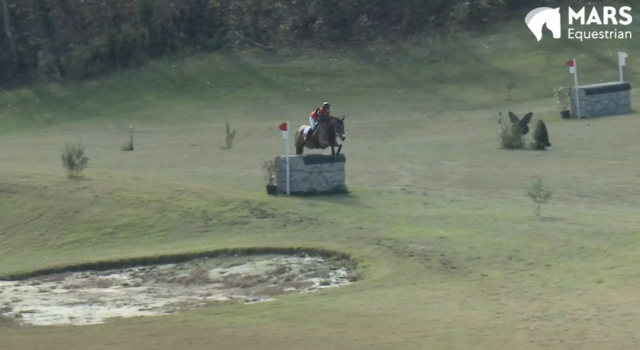
12:46 PM: Lauren Lambert and Fantastique and Megan Sykes and Classic’s Mojah are both now on course
12:43 PM: Lucienne and Mistralou have now crossed the finish line and Annie and Fedarman B make easy work of the big drop into the MARS Sustainability Bay.
12:41 PM: Oh dear, another problem at 6ABC. Our most recent starters Arielle Aharoni and Dutch Times run into trouble at the B element when Dutch Times says ‘no thank you’ and Arielle slips off.
12:39 PM: Whoops! Federman B jumps huge over the B element of fence 6ABC the FEI Stabling Boxes and Annie can’t quite collect him enough to get over to clear the C element. They make it over on their next try.
12:37 PM: Buck and Erroll Gobey have now finished. The other riders currently out on course are Jennie Brannigan and Twilightslastgleam, Lucienne Elms and Mistralou, and Annie Goodwin and Fedarman B.
12:30 PM: We just got work that Lauren Nicolson has withdrawn Landmark’s Monte Carlo and Hannah Sue Burnett has withdrawn her second ride Harbour Pilot, who was sitting in 8th after dressage.
12:27 PM: Buck and Erroll Gobey are now out on course and we also have some scores to update you on: Megan O’ Donoghue and Palm Crescent have finished under time but their score is showing 15 jump penalties which means they must have knocked a flag somewhere along the way, Kaelen Speck and Sweet Rebellion jump clear but add 24.8 time penalties, and Woods Baughman and C’est La Vie 135 were indeed clear and fast. They’ll take over the current lead on their score of 29.1.
12:24 PM: Star Witness takes some funny steps as she locks onto fence 10 the Moonshine Pipes. Doug looks back over his shoulder at something, but we’re not sure what.
12:21 PM: Doug Payne is also back again, this time with his super cool mare and Pan Am partner Starr Witness. He’s looking to give this mare a solid run to set her up for coming out strong next year.
12:19 PM: Boyd is back with his second of three rides in this division and her’s over the fence 8 with On Cue. Megan O’ Donoghue and Palm Crescent are coming up on the last jump and looking like they have plenty of time to spare. Kaelen Speck and Sweet Rebellion are also currently out on course now.
12:16 PM: Crap! A piece of equipment is dangling from Steady Eddie — it looks like a broken breastplate. Mike puts his hand up and opts to retire after 20ABC. That really stinks.
12:15 PM: We just got word that Jacob Fletcher has retired on course. We haven’t seen much of him on the live stream. Woods and “Contendro” have finished and looked quite fast. We’ll let you know when we get his time!
12:12 PM: Will and Don Dante are over the last and look like the had a good round and could be close to catching the time. Meagan O’Donahue and Palm Crescent are now our most recent starters.

12:09 PM: Steady Eddie is looking fresh for Mike Pendleton through 6ABC as they head out through the early portion of the course, but they get it done.
12:07 PM: Woods Baughman is now on course and looking quick with last year’s CCI3*-L National Champion C’est La Vie 135. This pair could take over the lead is all goes well.

12:03 PM: OH NO! Maya Black gets a dunking on the drop into the MARS Sustainability Bay as Miks Master C unsets her on landing.
12:02 PM: Will Coleman and Don Dante are now on course and looking super through the first 8 fences.
11:59 AM: We just got word that Sara and Reubens had a fall at the second to last fence, which is hugely gutting for that pair. Fortunately, they’re both up and OK but that’s still a disappointing finish to their weekend.
11:58 AM: Booli Selmayr has a huge smile on her face and give Millfield Lancado big pats as they cross the finish.
11:56 AM: Jacob Fletcher and 5o1 Mischief Managed are now on course and over 7AB Bridgett’s Squirrels.
11:54 AM: A few score updates here: Allison Springer and Business Ben came in 33 seconds over time, so they’ll ad 13.2 penalties to their core. Zach Brandt and Direct Advance racked up 20 penalties somewhere along the course and added 22 penalties in time as well.
11:50 AM: Booli Selmayr with Millfield Lancado and Nilson Da Silva with Rock Phantom now join Bobby and Sara on course. Sara is nearing home and is clear so far, but is looking tight on the clock possibly.
11:47 AM: Uhoh — Bobby runs into trouble at 20C as he can’t quite get Fortuna back after B element in time to jump C. They’ll pick up 20 there.
11:45 AM: Sara Kozumplik Murphy and Rubens D’ysieux are now on course and they have the ability to take the lead over from Ariel if they go fast and clear.
11:41 AM: Cornelia Dorr and Daytona Beach 8 are home with no jumping penalties. Waylon and Lancaster finished with 6 time penalties. Bobby Meyerhoff and Fortuna are now on course and Bobby ducks as they cross under the bridge at the FEI Stabling Water. Zach Brandt and Direct Advance are further along down the course and running through the final water.
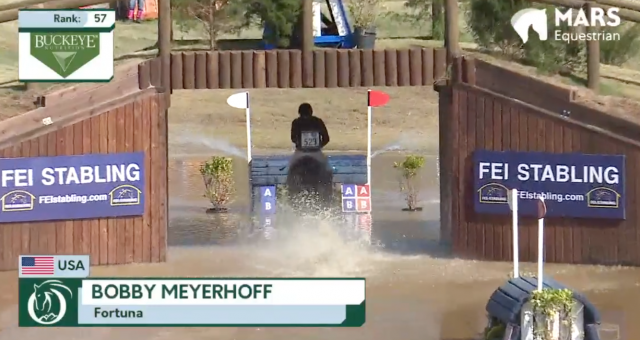
11:37 AM: Score update! Syndey Conley Elliott and QC Diamantaire are our third double clear pair. They’ll remain on their 30.60.
11:35 AM: Bummer … Dan Clasing has put his hand up with MW Gangster’s Game fairly close to the end of course. We’re not sure what happened, as it looks like they were going well up to that point.
11:33 AM: Alison Springer and Business Ben have left the start box and they should be fun to watch. Alison likes to joke that Ben loves cross country so much that he dreams about it.

11:30 AM: Waylon Roberts, Daniel Clasing, and Cornelia Dorr are our three current riders on course now. Daytona Beach 8 was a little wiggly on approach to the jump with the water works at fence AB, but Cornelia gets it done!
11:27 AM: What a run! Ariel and Simon are officially double clear, making the time easily in 9:45. That makes them the first sub-30 score to protect their placing after dressage. They’ll stay on their 29.90.
11:24 AM: Waylon and Lancaster are flying through the first part of the course, but Lancaster is looking a touch sticky. Ariel and Simon have now finished and they looked fast. We’ll keep an eye out for their official score. Sydney is now through the fence 19, the MARS Sustainability Bay.
11:21 AM: Ariel and Simon are looking super and seeing great distances. They’re through 20ABC.

11:19 AM: We just received word that Kate Brown and Victor Z have retired. Sydney Conley Eliot and QC Diamantaire are on course and clear through the fence 5 combination. Waylon Roberts and Lancaster are circling the box.
11:16 AM: We’re getting a shot of Marilyn and Kitty walking off course so it appears they are calling it a day. We have times in for Holly Jacks Smither who finished with 13.6 time and Phillip with Sea of Clouds who was once second over time.
11:14 AM: Ariel Grald and Leamore Master plan are over fence 1. Ariel was super thrilled with “Simon’s” dressage yesterday.
11:13 AM: Meanwhile, Leslie Law and QC First Class have been on course for a while and are nearing the end. Kate Brown and Victor Z are our most recent starters.
11:09 AM: And we will officially have a new leader at the end of the day. “Kitty” takes a big leap over the first squirrel at fence 7AB and runs out at the second.
11:07 AM: Our leaders after dressage are out of the box and on course now: Marilyn Little and RF Scandalous.
11:05 AM: Eek! Oh no, Lukeswell slips out behind while presenting to the C element of Fence 20 and runs out. Hannah Sue puts her hand up and calls it a day.
11:04 AM: We have our first double clear of the day! Will Faudree and Mama’s Magic Way came in at 9:51 — 9 seconds under time. Phillip Dutton and Sea of Clouds are also out on course now.
10:59 AM: Here’s a pair to keep our eyes on — Hannah Sue Burrnett and Lukeswell are on course now and they’re the first pair to take the long option at Fence 5AB which takes the pair over the bridge instead of under. They slip a bit on a tight turn, but look just fine.
10:53 AM: Canada’s Holly Jacks Smither and her OTTB More Inspiration are now on course and is making her way toward the squirrels. Will and Mason are clear thus far.
10:50 AM: We’re back underway and Will Faudree and Mama’s Magic Way aka “Mason” are on course. The announcers are guessing that the hold was just due to the grounds crew wanting to check the footing.
10:49 AM: There’s currently a hold on course but we haven’t received word as to why. No horses are currently on course. Tamie’s score with En Vogue is in and it shows 40 jumping penalties and 20 time will will drop them down the leaderboard
10:40 AM: We have some official scores in! Buck and Jak My Style are fastest so far, finishing in 10:07 — just four seconds over optimum. Jennie Brannigan and FE Lifestyle now sit in the early pole position as they finish in 10:14, adding 4.4 to their dressage score. Boyd and Blackfoot Mystery were clear with 8 time penalties, and Doug picked up 14 in time.
10:37 AM: Dang … En Vogue just canters right by the B element of 20 ABC. They’re carrying 40 penalties now.
10:35 AM: Boyd and Buck have both finished. Buck and Jak may have been fairly close to the time as he gives Jak big pats!
10:31 AM: Tamie Smith and En Vougue pick up a very unfortunate stop at fence 4. Huge bummer!
10:29 AM: Jennie Brannigan and FE Lifestyle are on course and over the squirrels at 7AB.
10:25 AM: Doug has crossed the finish line and announcer Tim Singer unofficially clocks him at 10:40, but says Doug planned to ride this horse at 80%. Buck Davidson and Jack My Style are also out on course now.
10:20 AM: Boyd Martin and his 2016 Rio Olympic partner Blackfoot Mystery have left the start box. Smooth sailing for Doug and Quantum Leap so far.
10:16 AM: And we’re off! Our first combination, Doug Payne and Quantum Leap are on course.
10:10 AM: As we await the first pair on course we’ve received word that the following combinations have withdrawn: Caroline Martin and Danger Mouse, Lauren Nicholson and Paramount Importance, and Clayton Fredericks with his two mounts FE Stormtrooper and FE Always in Time.
Before we start, take a quick walk thorough some of the key combinations with USA Eventing Technical Advisor Erik Duvander:














